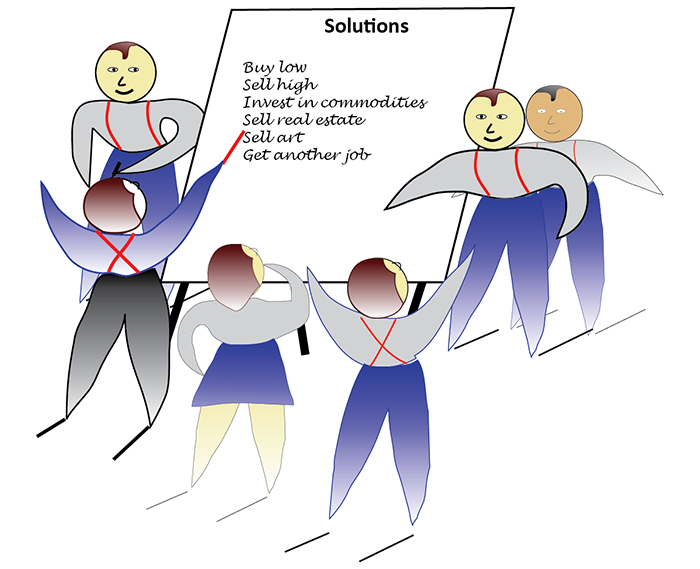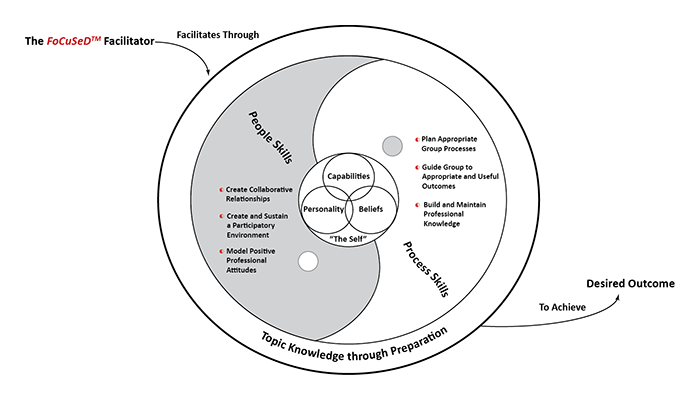
Brainstorming for Real | Gary Rush Facilitation
I’ve been reading a number of posts, lately, that talk about Brainstorming that cast a shadow over its use and effectiveness. The way the posts described Brainstorming tells me “why” they had issues with it – it wasn’t executed properly. The term “brainstorming” has been around for over 75 years and many have heard the term. Unfortunately, few have learned “how to” execute it properly – people frequently think that brainstorming is listing out a lot of unconstrained ideas and then they’re done. That is unfortunate because Brainstorming is so much more.
Alex Osborn developed Brainstorming in 1939. At the time, he was CEO of BBDO (he is the “O”), an advertising firm out of New York. He wrote about Brainstorming in his book, Applied Imagination: Principles and Procedures of Creative Problem-Solving. In developing Brainstorming, he felt ideation needed to be separated from evaluation so that all sorts of ideas could emerge. Humans, he felt, dismissed ideas as absurd or ineffective too quickly. He was right – we edit our ideas too quickly and miss out on creative and/or innovative ideas because some of those absurd ideas become the gems once we analyze them. He didn’t say to eliminate evaluation, though. Too many practitioners don’t evaluate or evaluate days later after the fact, or have no clue how to evaluate. They forget that Osborn developed Brainstorming as a means to an end, not the end. You have to work through the ideas (analyze) after you list them – that’s when the innovation and creativity come into play. Here’s “how” I teach and do Brainstorming.
Effective Brainstorming
Step One – Frame the question.
First, set the context clearly. Brainstorming requires a properly framed question. “What are we going to do?” is broad and directionless. “How do we solve this ___?” is clearer and answerable.
Step Two – Give them time to think.
Osborn said to give the people about 5 minutes to quietly jot down ideas on their own. This is important in engaging introverts and our brains. People generally jump into listing without thinking. That loses the introverts and assumes that our brains are fully engaged – both inaccurate.
Step Three – List out unconstrained ideas.
This is the part of Brainstorming that most people are familiar with – the unconstrained listing of ideas. The thing is to ensure that no one edits or questions any idea. Whatever is said, stays on the list, even duplicate or fuzzy ideas. I use Flip Charts, I find it easier to capture the ideas and it allows the people to see the list helping to trigger more ideas. It is important to label the flip charts, e.g., if listing solutions, label “solutions”. Don’t use vague terms, such as “ideas” or “stuff”. The label helps remind the people what they are listing. I also enforce the rules: no editing, no discussion, no questions, and all ideas are allowed.
There are alternatives to listing. Two that I use are Small Groups and Brain Writing. Small Groups involves breaking the group into small groups of 3 to 5 people and having each small group do their own brainstorm listing following the same rules. Then, you bring the small groups together to share their ideas. Working in small groups is also safer for quiet or shy people. With Brain Writing, I give each person a 4” x 6” or larger pad of Post-it’s and tell them to write out their ideas – one idea per piece of paper. I collect the ideas, or I ask each person to read out his or her ideas, and post them up on a wall to analyze. This is even safer than small groups and facilitates clustering or organizing the ideas, if appropriate.
Step Four – Analyze the list of ideas.
This is the step that many people neglect or do poorly. Brainstorming is a means to an end, so you need to know the end result – the key is to plan ahead of time. Too many people immediately “group” ideas. I always ask, “What are you doing with the groups?” If they don’t have an answer, then why do it? Others immediately use dots (Dot-voting or Dotmocracy) to “prioritize” the ideas. They forget that the ideas were just listed and most are vague and not fully formed therefore they are not ready for prioritizing.
Each list you develop is analyzed differently:
- If I’m looking for solutions to a problem, then we discuss each idea, clarify it, and eliminate duplicates. Then we discuss (or brainstorm) criteria for keeping or eliminating ideas. We then use the criteria to assess the list of ideas. We may prioritize the final list if we need to pick one solution or rank them.
- If I’m looking for objectives, we discuss each list item and validate if it can be made SMART (Specific, Measurable, Achievable, Relevant, Time-based). If it can be, then we discuss it to make it SMART, if not, it’s not an objective and is removed.
To analyze properly, you need to know the end result – not the specific answer, but what it is. That takes planning. When you analyze properly, innovation and creativity come into play. The listing gives the group raw material to work with. The analysis turns the raw material into creative, innovative, and usable ideas. This step is the most important step in making Brainstorming useful.
Don’ts
I never use the word “brainstorming” in my facilitated workshops/meetings. People either have a misconception about brainstorming or have had a bad experience. The easiest way to introduce it is, “We are going to list ___ without arguing, questioning, or criticizing. Then, we’ll analyze the list and you can argue, question, and criticize, but I’ll tell you how we will do that when we get there.” That always works for me.
I never write “brainstorming” on my agenda. It is a means to an end, so write out the end, e.g., if we are brainstorming how to solve a problem, instead of writing brainstorm, I write solutions.
I’ve heard people call for a “Brainstorming Session”. I have no idea what that is. Again, what is the end result? We may have a session to generate solutions for a problem or objectives for a business, etc., but we don’t have a “brainstorming” session – it’s a tool. Call it what it is.
So…
Brainstorming, done as Alex Osborn described is effective and works well. It enables people to generate a lot of ideas and then make sense of them for the end result, provided that you know how to analyze the ideas. It always boils down to know where you are going – plan ahead. ![]()





